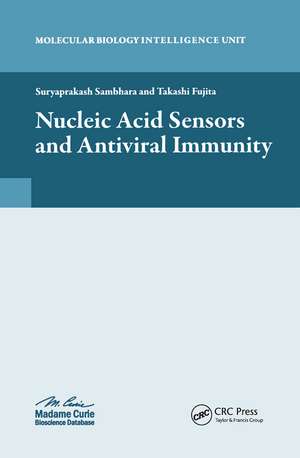Nucleic Acid Sensors and Antiviral Immunity
Autor Dr. Prakash Sambharaen Limba Engleză Paperback – 2 dec 2019
Nucleic Acid Sensors and Antiviral Immunity presents a timely and extensive account of the detection of nucleic acids in infection and inflammation. We have chapters by Beutler, Hoffman and Shizuo Akira, who is the most cited immunologist of the past ten years, for his work on innate immunity, which gives us an indication of the importance of the field. Several other pioneers in the field present comprehensive and highly lucid up-to-date accounts of their particular interests, revealing the large amount of activity in the past few years, as the literature continues to grow and become ever more complex. The fly yet again provides new insights, and anti-viral mechanisms in this key model organism are described. Other topics include the ability of viruses such as poxviruses, hepatitis C virus and HIV to interfere with detection and signalling; new insights into signalling including subcellular localization of signalling proteins, complex regulation o
Preț: 458.44 lei
Preț vechi: 539.34 lei
-15% Nou
Puncte Express: 688
Preț estimativ în valută:
87.75€ • 95.35$ • 73.76£
87.75€ • 95.35$ • 73.76£
Carte tipărită la comandă
Livrare economică 21 aprilie-05 mai
Preluare comenzi: 021 569.72.76
Specificații
ISBN-13: 9780367445904
ISBN-10: 0367445905
Pagini: 284
Dimensiuni: 152 x 229 x 15 mm
Greutate: 0.38 kg
Ediția:1
Editura: CRC Press
Colecția CRC Press
ISBN-10: 0367445905
Pagini: 284
Dimensiuni: 152 x 229 x 15 mm
Greutate: 0.38 kg
Ediția:1
Editura: CRC Press
Colecția CRC Press
Public țintă
Academic and Professional ReferenceCuprins
1. Antiviral Responses in Invertebrates 2. Overview of TLRs 3. Nucleic Acid-Sensing TLR Signaling Pathways 4. Alternative Regulatory Mechanisms of TLR Signaling 5. Intracellular Viral RNA Sensors: RIG-I Like Receptors 6. Contribution of LGP2 to Viral Recognition Pathways 7. The Mitochondrial Immune Signaling Complex 8. DNA Sensors and Anti-Viral Immune Responses 9. Mechanisms of Interferon Antagonism by Poxviruses 10. Innate Immune Evasion Strategies of HCV and HIV: Common Themes for Chronic Viral Infection 11. Innate Immune Evasion Strategies of Influenza A Virus 12. Autophagy in Antiviral Immunity 13. Synthetic and Natural Ligands of RLR 14. Antiviral Actions of Double-Stranded RNA 15. Ligands of Pathogen Sensors as Antiviral Agents
Descriere
This book presents an account of the detection of nucleic acids in infection and inflammation. It addresses innate antiviral responses in invertebrates and provides an overview of Toll-like receptors in vertebrates. The book also provides an in-depth coverage of nucleic acid sensing pathways.
